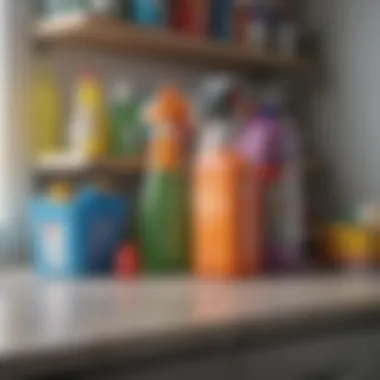Effective House Cleaning Strategies for Every Space


Intro
Cleaning a house can feel overwhelming. Many people struggle to maintain order and cleanliness within their living spaces. Yet, with efficient cleaning strategies, this process can be streamlined. This article seeks to navigate the various elements involved in house cleaning, presenting organized methodologies that cater to diverse spaces. As we explore these strategies, the importance of a clean environment—both for health and aesthetic reasons—will be emphasized.
Planning plays a crucial role in successful house cleaning. Thoughtful organization allows individuals to maximize their efforts while minimizing time spent on chores. The discussion will encompass specific challenges faced during cleaning and offer tailored solutions that resonate with those who are passionate about creating inviting living spaces.
Home Features
A home’s structure and design greatly impact cleaning efficiency. Understanding the features of a home can aid in formulating effective cleaning strategies.
Architectural Marvels
Certain design elements can complicate cleaning. High ceilings and large windows may look stunning but can accumulate dust and dirt. Managing these architectural components requires specific tools and methods. Using extension dusters and proper vacuum attachments can simplify the maintenance of such features.
Unique Design Elements
Many homes boast unique features, such as intricate moldings or specialized flooring. Each element presents its own cleaning challenges. For instance, hardwood floors require specific cleaning solutions to avoid damage, while tile surfaces may need different approaches to maintain their luster. Understanding these unique features is vital for effective cleaning.
Interior Design Inspirations
A well-designed interior can ease the cleaning process. Thoughtful decor choices may improve accessibility and reduce clutter.
Color Palettes and Themes
Selecting light colors for walls can promote a sense of cleanliness and spaciousness. Darker colors, while stylish, often show dust and smudges more easily. Understanding this relationship can help in making informed choices that complement cleaning efforts.
Furniture Arrangement Tips
The way furniture is arranged affects cleaning efficiency. Open layouts enable easier access for vacuuming and dusting. Consider utilizing multi-functional furniture to reduce clutter, which can simplify cleaning routines.
"A clean house is a sign of a wasted life." This saying emphasizes the balance we must seek between livability and cleanliness.
Understanding the Importance of Cleaning
Cleaning is not just a chore but a fundamental aspect of maintaining a healthy living environment. The significance of cleaning goes beyond mere aesthetics; it is deeply intertwined with health, safety, and efficiency.
Health Considerations
A clean home significantly reduces the risk of illness and allergies. Dust mites, mold, and pet dander can accumulate in neglected corners, posing health risks. Regular cleaning helps to eliminate these threats. Moreover, germs can thrive in uncleaned areas, especially in kitchens and bathrooms. Thus, understanding the health implications of cleaning can motivate individuals to prioritize this task. Investing time in thorough cleaning can lead to a significant decrease in respiratory issues, allergy symptoms, and other health concerns.
Aesthetic Benefits
The visual appeal of a tidy home cannot be underestimated. A clean and organized space enhances mental clarity and reduces stress. Cluttered environments often contribute to feelings of chaos, while a well-maintained space promotes relaxation. It is also important for those who entertain guests. A clean living space sends positive signals about one’s lifestyle. Attention to cleanliness reflects personal values and care for one’s surroundings.
Efficiency in Time Management
Cleaning, when systematically organized, can save time in the long run. Establishing routines for daily, weekly, and monthly cleaning tasks allows individuals to manage their time better. Instead of spending hours in one big cleaning session, dividing tasks throughout the week creates a less overwhelming experience. This makes it easier to maintain the home while also fitting in time for other activities. The key is to be consistent and intentional in cleaning efforts.
"A little progress every day adds up to big results."
Setting Up a Cleaning Schedule
Setting a cleaning schedule is vital for maintaining an efficient cleaning routine. It brings structure to your cleaning efforts and helps eliminate the ambiguity of what needs to be done when. A well-organized schedule will save time and reduce stress. It allows for regular maintenance, ensuring that no task is overlooked.
A good cleaning schedule considers the frequency of different tasks, balancing daily, weekly, and monthly efforts. This approach eases the burden of cleaning, making it manageable and not overwhelming.
Identifying High-Traffic Areas
High-traffic areas in a home are places prone to gathering dirt and clutter. They typically include hallways, living rooms, kitchens, and entryways. Identifying these spaces is essential because they require more frequent cleaning. By focusing on high-traffic areas, you can prioritize your efforts and allocate more time to maintaining these zones.
To recognize high-traffic areas:
- Observe daily activities: Note where family members gather and spend most time.
- Check for wear and tear: Areas that show signs of dirt buildup or stains need attention.
This targeted approach allows you to manage your time efficiently, ensuring that these areas do not become overwhelming.


Assigning Tasks
After identifying high-traffic areas, it is important to assign specific cleaning tasks. This ensures everyone in the household is responsible for maintaining cleanliness. Assigning tasks can be done in various ways, considering the household structure.
For families:
- Divide tasks based on age: Older children can handle more complex tasks, while younger ones might take care of tidying up.
- Rotate responsibilities: Changing tasks on a weekly basis keeps things fresh and ensures that no one feels burdened.
For individuals or couples:
- Create a checklist: Having a list assists in keeping track of what has been done and what still needs attention.
- Set specific days for particular chores: Designating days for tasks, such as vacuuming on Mondays, ensures accountability.
Creating a Cleaning Calendar
Establishing a cleaning calendar is pivotal to sustaining a cleaning schedule. This calendar should outline daily, weekly, and monthly activities and provide a visual reminder of chores.
To create an effective cleaning calendar:
- List all tasks: Begin with a comprehensive list of all cleaning chores.
- Categorize by frequency: Assign tasks to specific days based on how often they need to be done, separating daily, weekly, and monthly chores.
- Use digital tools: Consider utilizing digital calendars or apps that send reminders about cleaning tasks.
"A structured calendar transforms cleaning from a sporadic chore into a systematic activity, leading to a consistently maintained living space."
In summary, a thoughtful schedule can make cleaning less of a chore and more of a routine. Engaging every member in house cleaning creates a sense of ownership and accountability, facilitating a harmonious living environment.
Selecting Appropriate Cleaning Supplies
Selecting the right cleaning supplies is pivotal in achieving a spotless home efficiently. The tools and products you choose impact not only the results of your cleaning efforts, but also the time and energy you expend during the process. When making these selections, it is essential to consider factors such as effectiveness, environmental impact, and safety for household members. The right supplies can streamline your routine, making cleaning less of a chore and more of a straightforward task.
Eco-Friendly Options
In today's world, eco-friendly cleaning supplies have gained importance for many households. These products are made from natural ingredients, avoiding harsh chemicals found in traditional cleaners. Such options not only reduce environmental damage but also create a safer indoor environment for families and pets. When you opt for eco-friendly products, you support sustainability and are often met with less scent irritation or allergy triggers. To select these products effectively, look for certifications or labels indicating environmentally safe practices. Always check the ingredient list, prioritizing biodegradable options that won't harm local water sources.
Essential Tools
Being armed with the right cleaning tools is as important as the cleaners themselves. A blend of traditional and modern tools can significantly enhance your cleaning efforts.
Mops and Brooms
Mops and brooms remain staples in household cleaning. They assist in maintaining clean floors, which is essential in any cleaning regimen. The main characteristic of mops is their ability to absorb spills, while brooms effectively remove dust and debris. Mops come in various styles, such as sponge mops or microfiber mops, each providing unique cleaning strengths. Choosing between them depends on the floor type and personal preference. Their advantage lies in their simplicity and effectiveness for quick cleaning tasks.
However, traditional brooms can sometimes scatter dust before it is collected. A vacuum cleaner might complement this while offering convenience for larger debris.
Vacuum Cleaners
Vacuum cleaners bring efficiency to cleaning carpets and rugs, making them a crucial tool in any home. The standout feature of vacuum cleaners is their suction ability, which removes dirt and allergens from surfaces thoroughly. They come in numerous types, such as upright, canister, and robot vacuums. A vacuum’s versatility is notable; they can clean various surfaces, including upholstery and hard floors. The benefit of using a vacuum is that it helps maintain indoor air quality by capturing dust particles. However, they require regular maintenance to ensure they function optimally, which could be seen as a disadvantage compared to simpler tools.
Cleaning Cloths
Cleaning cloths play a vital role in a successful cleaning strategy. These cloths are available in different materials, including microfiber, cotton, and sponge varieties. What makes microfiber cloths stand out is their ability to trap dirt and germs effectively without chemicals. They are soft yet durable, allowing them to be washed and reused, reducing waste significantly. Various uses include wiping surfaces or even drying dishes. One drawback could be that they require care in washing and drying to maintain their effectiveness.
Organizing Cleaning Supplies
The organization of cleaning supplies can drastically reduce the time spent locating products necessary for each task. Start by designating a specific space for all cleaning materials. This could be a cabinet or a container that can be easily accessed. Consider sorting items based on the area they will be used in, like kitchen cleaners together, and bathroom items in another section. Labeling these containers can increase efficiency. Also, store cleaning tools in a manner that will allow easy reach without creating clutter. Regularly check supplies to replace anything that runs low. Good organization ensures that each cleaning session is less about finding supplies and more about achieving a clean space efficiently.
Developing Cleaning Techniques
Cleaning techniques are critical in ensuring an efficient and effective house cleaning strategy. A methodical approach to cleaning not only enhances cleanliness in the home but also saves time and effort. By establishing a structured routine, one can optimize every cleaning task.
Top-Down Cleaning System
The top-down cleaning system is built on a simple premise: clean the higher surfaces first and move downward. This approach prevents dust and debris from falling onto areas that have already been cleaned. When cleaning a room, start with the ceiling fans and shelves and work down to countertops and floors.
Benefits of this method include:
- Maximized efficiency: Reduces the need to re-clean surfaces.
- Systematic flow: Creates a logical order to follow.
- Time-saving: Less time spent on repetitive tasks.
The application of this technique can be particularly visible in spaces like the kitchen and bathroom, where surfaces need careful attention.
Room-by-Room Approach


Adopting a room-by-room approach provides focus and prevents the feeling of being overwhelmed. By concentrating on one room at a time, it becomes easier to manage tasks effectively. Clearing clutter, dusting surfaces, and vacuuming can be tackled in a systematic fashion for each room.
Some advantages include:
- Increased productivity: Completing one room at a time tends to motivate.
- Easier tracking of progress: Visualizing completed tasks can boost morale.
- Reduced distractions: Minimizing task-switching helps maintain momentum.
To implement this, follow a checklist for each room, ensuring that every area receives the attention it deserves without rushing.
Incorporating the Five-Second Rule
The Five-Second Rule can enhance cleaning efficiency. The rule is simple: if you see an item out of place, take a few seconds to put it back where it belongs. This small action can lead to significant improvements in tidiness over time.
Key considerations include:
- Habit formation: Regular practice can help form a routine.
- Clutter reduction: Ongoing effort prevents mess from accumulating.
- Maintaining order: Enhances overall organization of spaces.
Training oneself to embrace this rule empowers individuals to keep their surroundings organized without extensive effort.
It takes only a moment to create a cleaner, more organized home. Small actions can lead to big changes.
Utilizing these techniques can lead to a more systematic, efficient approach towards cleaning. Establishing a routine that integrates these methods not only enhances the quality of cleaning but also fosters a cleaner living environment.
Room-Specific Cleaning Strategies
Effective house cleaning requires awareness of individual spaces and their unique demands. Room-specific cleaning strategies recognize that each area in a home has distinct features and usage patterns that affect cleaning needs. By customizing cleaning techniques for different rooms, one can achieve better efficiency and results. This approach helps to ensure no area is neglected and cleaning becomes more systematic.
Living Room Maintenance
The living room is often the heart of the home, where families gather and guests are entertained. Regular maintenance is vital. Dusting surfaces should be done weekly. Use a microfiber cloth to trap dust effectively. Keep furniture organized, and declutter surfaces to create a welcoming atmosphere.
For deeper cleaning, consider vacuuming carpets thoroughly and tackling upholstery stains promptly. Use products suitable for the fabric to maintain the aesthetic appeal. Remember to incorporate book and media clutter removal into your routine; this keeps the living room tidy and more inviting.
Kitchen Deep Cleaning
The kitchen is arguably the most used space in a house, requiring a more rigorous deep cleaning process. Start with appliances; cleaning the refrigerator and oven should be on the monthly schedule. Remove any expired items from the fridge and wipe down surfaces with a disinfectant.
Pay special attention to countertops. They should be sanitized regularly to prevent foodborne illnesses. A deep clean of the kitchen also involves scrubbing the sink and wiping down cabinets. To maintain order, organize pantry items and dispose of any expired products. Keeping kitchen surfaces clear enhances the overall functionality of this critical space.
Bathroom Care
Bathrooms are high-moisture areas. They require regular cleaning to avoid mold and mildew buildup. A weekly cleaning schedule can keep these issues at bay. Focus on disinfecting the toilet, sink, and shower areas. Use products designed to tackle soap scum and hard water stains.
Monthly, conduct a more thorough check. Scrub tile grouts, clean the shower curtain, and check drainage for blockages. Also, decluttering bathroom items reduces visuals clutter, creating a more serene environment. Choose storage solutions that optimize space without compromising accessibility.
Bedroom Tidying Techniques
Bedrooms should serve as retreats for rest and relaxation. To maintain a peaceful environment, establish a routine for daily tidying. Make the bed each morning and keep surfaces clear of unnecessary items.
For deeper cleaning, consider laundering bed linens every one to two weeks. Vacuum under the bed and ensure that closet spaces are organized. Managing wardrobe clutter can prevent overwhelm and helps in selecting outfits quickly. Regular maintenance prevents buildup, ensuring a pleasant environment.
Laundry Room Considerations
The laundry room often becomes a catch-all space, which may hinder its functionality. To optimize this room, first, clear out items that do not belong. Regularly clean the washer and dryer, focusing on lint traps and detergent compartments.
Establish a sorting system for laundry to make the process more efficient. Consider labeling bins for whites, colors, and delicates. This practice can streamline the workload, reducing time wasted on sorting. A well-maintained laundry room contributes to a more organized household.
Understanding the unique needs of each room is crucial to effective house cleaning.
Incorporating these room-specific strategies can elevate cleaning efforts. By targeting the specific needs of each space, one can create a cleaner and more organized home. Consistency in these practices promotes a healthy and aesthetically pleasing environment.
Incorporating Technology into Cleaning
In today’s fast-paced world, technology plays a significant role in streamlining various aspects of life, including cleaning. The advancement of smart devices and applications offers not only convenience but also efficiency in maintaining a clean living environment. This section explores how integrating technology into cleaning practices can lead to more effective and consistent results.
Using Smart Home Devices


Smart home devices have revolutionized how we approach cleaning. Products like robotic vacuums from iRobot’s Roomba or Roborock not only automate routine tasks but also help in saving time and energy. These devices can navigate your home’s layout, cleaning floors automatically while you engage in other activities. Their programmable features allow users to schedule cleaning sessions or control them remotely via smartphones.
Consider the advantages of having a smart device:
- Automation: Set cleaning schedules, and let the device handle the work.
- Integration: Sync with other devices in your smart home ecosystem.
- Sensor Technology: Detect dirt and obstacles, optimizing cleaning paths.
The incorporation of smart home devices not only enhances cleanliness but also contributes to overall quality of life by providing more free time.
Apps for Cleaning Management
In addition to smart devices, various applications are available that facilitate effective cleaning management. These apps range from task organizers to reminders that help keep your cleaning schedule on track. For instance, the Todoist app helps users create checklists and set deadlines for specific cleaning tasks.
Key benefits of using cleaning management apps include:
- Task Organization: Break down larger cleaning projects into manageable tasks.
- Reminders: Set alerts for regular maintenance routines such as dusting or window washing.
- Performance Tracking: Record completed tasks to visualize progress over time.
A well-designed cleaning management app can transform a chore into a systematic and organized process, hence supporting your quest for cleanliness in your home.
Overall, the integration of smart devices and cleaning management apps transforms cleaning from a mundane and overwhelming task into a structured routine that promotes efficiency and ease. By leveraging technology, you can ensure that your cleaning efforts are optimized, leaving you with a pristine environment and more time for other pursuits.
Developing Sustainable Cleaning Habits
Sustainable cleaning habits are crucial not only for maintaining a clean home but also for ensuring that the cleaning practices are environmentally responsible. These habits foster a consistent approach to cleaning that minimizes the effort required while maximizing the results. By developing sustainable cleaning habits, individuals can create a cleaner, healthier living space while being mindful of their environmental impact.
When we speak of sustainability in cleaning, we think of methods and products that reduce waste and use less harmful chemicals. Using eco-friendly cleaning supplies is one element that aligns with this principle. This means choosing biodegradable products or even creating your own cleaning solutions using natural ingredients. The benefits of integrating these practices extend beyond personal health; they contribute to a more substantial environmental impact by reducing chemical runoff and waste.
Daily Maintenance Routines
Implementing daily maintenance routines is a core element of sustainable cleaning habits. A structured approach to daily cleaning can make a significant difference in overall cleanliness and prevent larger issues from arising. For example, taking a few minutes each day to tidy up can save hours of effort later.
Here are practical daily maintenance tips that can easily fit into any schedule:
- Make Your Bed: A tidy bed instantly makes the room look organized.
- Wipe Surfaces: Use a damp cloth to quickly wipe down surfaces, preventing dust build-up.
- Laundry Management: Try to manage laundry efficiently. If you have clothes that need to go to the hamper, do it immediately instead of putting it off until later.
- Dishes and Kitchen Cleanup: Avoid piling dishes in the sink. Clear them right after meals.
Learning to include these small tasks as part of an everyday routine creates a habit that leads to less extensive cleaning sessions.
Monthly Deep-Cleaning Tasks
While daily habits are essential, incorporating a system for monthly deep-cleaning tasks is equally important. This practice not only maintains cleanliness, but it also addresses areas that require more attention over time. People often overlook specific cleaning tasks, and monthly deep-cleaning acts ensure that nothing falls through the cracks.
Here are some deep-cleaning tasks to consider every month:
- Scrubbing Floors: Go beyond daily sweeping and do a thorough mop of all floors in the home.
- Dusting Hard-to-Reach Areas: Take time to dust ceiling fans and high shelves.
- Appliance Cleaning: Clean the inside of your oven, refrigerator, and microwave.
- Bathroom Deep-Cleans: Focus on grout lines and behind fixtures, which can accumulate grime.
- Declutter: Take a month to go through areas that often get cluttered, such as drawers and closets.
By adhering to a monthly schedule, you minimize the stress of extensive cleanings. This method allows you to maintain a secure and pleasant environment year-round.
"Consistent effort through daily and monthly practices shapes the foundation of effective cleaning."
The integration of these sustainable habits not only makes cleaning manageable, but it promotes a clean atmosphere that can be enjoyed by all.
By focusing on sustainability through diligent habits, the process of cleaning becomes less of a chore and more of a lifestyle. The long-term benefits of developing such habits are substantial, leading to a healthier home and a more responsible approach to cleaning.
Managing Expectations and Mental Approach
Cleaning a house is often seen as a large and daunting task. One of the critical aspects that can make or break the cleaning experience is managing your expectations and adopting a mental approach that is constructive and practical. The right mindset helps in transforming what may typically come off as a chore into an organized and systematic task that can be completed efficiently. When one has a clear understanding of what is achievable, it reduces anxiety and improves the overall cleaning experience.
Realistic Goals in Cleaning
Setting realistic goals is integral to moving forward with house cleaning. It is essential to identify what can be accomplished in a designated time frame without overwhelming oneself. Here are a few guidelines to set effective cleaning goals:
- Assess the Condition of Your Space: Take a moment to evaluate how much cleaning needs to be done. This first step allows you to create a detailed plan.
- Break Down Tasks: Divide the cleaning areas into manageable tasks. For example, cleaning the kitchen can include wiping surfaces, washing dishes, and mopping the floor. This segmentation helps in preventing procrastination.
- Limit Cleaning Time: Allocate a specific time for each cleaning task. For example, setting a timer for 20 minutes allows you to focus on cleaning without feeling overwhelmed.
By approaching cleaning with specific, achievable goals, one can better manage expectations and ensure that each cleaning session is productive.
Maintaining a Positive Mindset
A positive mental attitude plays a significant role in how you perceive and carry out cleaning tasks. Here are some simple strategies to maintain a positive mindset:
- Celebrate Small Wins: Recognize and reward yourself for completing tasks, no matter how small. Completing one room or even a section can boost morale.
- Practice Mindfulness: Engage in the moment. Focus on the cleaning task at hand rather than stressing about everything that remains to be done. This focus can make tasks feel less tedious.
- Use Music or Podcasts: Listening to something engaging can turn a mundane task into an enjoyable one. Choose something uplifting or enriching to keep the energy positive.
A positive mindset is not just about feeling good; it shapes how effectively you can perform your cleaning tasks.
Managing expectations and cultivating a positive approach can lead to a more efficient cleaning routine. By acknowledging what is attainable and adopting an enthusiastic mindset, individuals can significantly enhance their cleaning experiences. A mentally prepared individual is often more productive, leaving a cleaner, healthier home.



